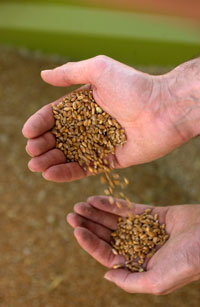Half of all malting barley could fail

Up to 50% of the malting barley crop could fail to reach the required specification, with high nitrogen contents causing considerable problems.
“The drought has really pushed nitrogen levels up this year and even the later winter barleys on the more drought resistant soils are trending higher,” said Stuart Shand, sales director at Gleadell Agriculture.
“It is not uncommon for growers who normally get 1.6% nitrogen to have a shed full of 2% or over.”
Yields were 20-30% lower than normal, with some yields halved on light lands in East Anglia, he added.
“Even though the maltsters have raised their acceptance levels, supply is going to be vastly reduced and the demand will have to be met using extra spring barley.”
Usually, maltsters bought winter barley up to a maximum of 1.8%, but they had already relaxed their intake to 1.9% or even 2% in some cases.
Yields – and therefore nitrogen contents – varied widely within fields, making it difficult to accurately test grain heaps, warned Mr Shand.
Today (4 August) samples had come in with nitrogens between 1.78% and 2.2% within the same field. “Unless your crop is safely within a specific maltster’s parameters do not send it to them.”
Spring barley was suffering from similar problems, he added. “We have growers who usually grow 1.65% nitrogen crops; this year they are 1.75-1.8%.”
Yields ranged from 1.85t/ha to 9t/ha (0.7-3.6t/acre). “But overall, we’re pleasantly surprised at yields and nitrogen levels.”
Today, samples were coming in at 1.56% to 2.09% nitrogen, with most in the 1.7-1.9% range.
“Maltsters are still trying to persuade their customers – the brewers – to relax their nitrogen tolerances even further. But brewers want to see more spring results before they make any decisions.”

